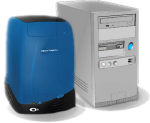After a long wait I finally managed to get TopModel to my RISC OS software collection.
TopModel is one of the few 3d-apps for the RISC OS, and maybe the only proper 3d-modelling software that was ever made for the platform. It is only intended for modelling, but can also render the finished result to a 24bpp high-res image. Finished models can be converted and raytraced on another app if needed.
Too bad there never was a 32-bit version, and the software disappeared sometime after TopModel 2. In my screenshot it is barely running with the help of Aemulator and it will crash when you try to do almost anything. That is why the image is not very exciting.
I have only done a quick test with the help of my old Acorn A4000, and found the program is actually pretty good for what it was made to do. It runs suprisingly well with an ARM250 processor (ARM2, 12.5 MHz) and 4MB RAM. Program comes with 4 disks, but the actual app fits in only 1 disk. Other 3 disks are for utilities/resources. TopModel uses Gemini (Similar to software OpenGL) to render a "realtime" shaded preview of the models/scene when working with the program.
TopModel is one of the few 3d-apps for the RISC OS, and maybe the only proper 3d-modelling software that was ever made for the platform. It is only intended for modelling, but can also render the finished result to a 24bpp high-res image. Finished models can be converted and raytraced on another app if needed.
Too bad there never was a 32-bit version, and the software disappeared sometime after TopModel 2. In my screenshot it is barely running with the help of Aemulator and it will crash when you try to do almost anything. That is why the image is not very exciting.
I have only done a quick test with the help of my old Acorn A4000, and found the program is actually pretty good for what it was made to do. It runs suprisingly well with an ARM250 processor (ARM2, 12.5 MHz) and 4MB RAM. Program comes with 4 disks, but the actual app fits in only 1 disk. Other 3 disks are for utilities/resources. TopModel uses Gemini (Similar to software OpenGL) to render a "realtime" shaded preview of the models/scene when working with the program.








